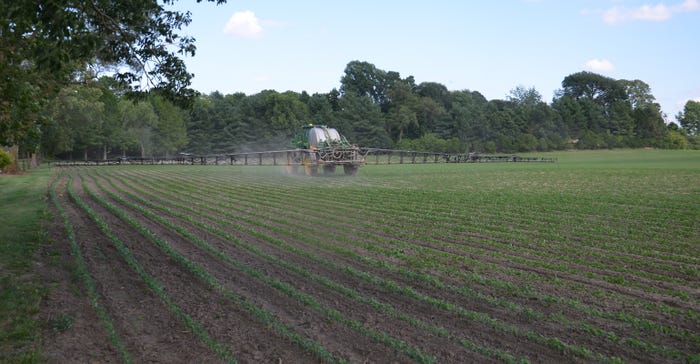
How do you prevent weed issues in soybean fields that were sprayed before or at planting and are in the vegetative stage? Bill Johnson, Purdue University Extension weed control specialist, says it requires knowledge about your field and crop. It also takes planning to make sure you won’t have serious weed issues later.
Here are two examples Johnson examined from photos. His observations might trigger your thinking process.
1. Split-row, no-till soybeans. Look at the picture above. “Scout the field and look for weeds, especially marestail and waterhemp,” Johnson says. “They should be small here. That’s when you want to make a postemergence application. You don’t want them taller than 4 inches.”
What you can spray if you find these weeds depends on the technology in the soybean plants. If they’re Enlist E3 soybeans, you could use Liberty and a 2,4-D choline product. For Xtend beans, dicamba is an option. If they’re XtendFlex, then approved dicamba and Liberty formulations are options.
What if you only find a patch or two of waterhemp plants? “I would spray the entire field and include a Group 15 residual herbicide,” Johnson says. Make sure it’s an approved tankmix partner for other herbicides you’re using.
“Waterhemp can continue germinating, and the residual helps control those that might attempt to germinate,” he explains. What you don’t want is waterhemp extending above the canopy later, as shown in the photo below.

DON’T WANT THIS: Here is what you are trying to avoid with a herbicide program. Waterhemp can germinate late and poke through the crop canopy if weed control wasn’t planned properly.

2. 30-inch-row, conventional-tillage soybeans. For the picture below, what should be in the spray tank comes down to the same two questions, Johnson says. What weeds are in the field? What technologies do soybean plants have for herbicide tolerance?

ADD TO TANK? Which herbicides should be in the tank in this wide-row situation for the best possible weed control success?

“Base your post herbicide choice on those technologies,” Johnson says. “The important thing again is to include a Group 15 residual herbicide. You won’t get canopy as quick here. It’s very important to have a residual which will still be active against late-germinating weeds.”
About the Author(s)
You May Also Like




